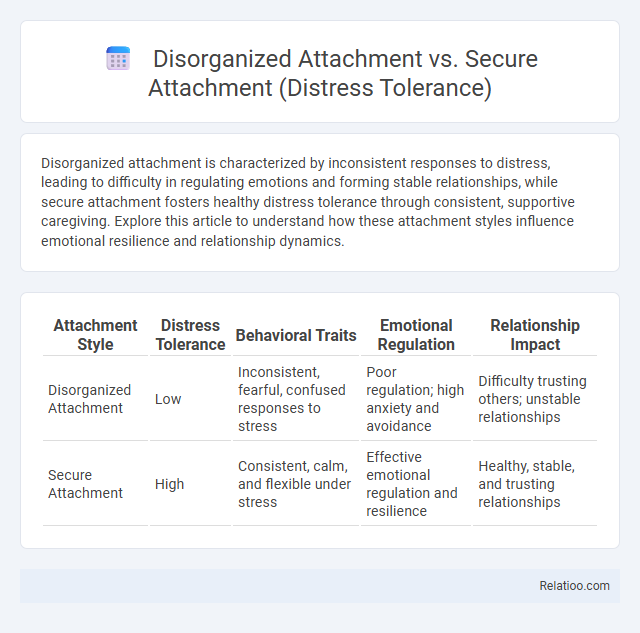Disorganized attachment is characterized by inconsistent responses to distress, leading to difficulty in regulating emotions and forming stable relationships, while secure attachment fosters healthy distress tolerance through consistent, supportive caregiving. Explore this article to understand how these attachment styles influence emotional resilience and relationship dynamics.
Table of Comparison
| Attachment Style | Distress Tolerance | Behavioral Traits | Emotional Regulation | Relationship Impact |
|---|---|---|---|---|
| Disorganized Attachment | Low | Inconsistent, fearful, confused responses to stress | Poor regulation; high anxiety and avoidance | Difficulty trusting others; unstable relationships |
| Secure Attachment | High | Consistent, calm, and flexible under stress | Effective emotional regulation and resilience | Healthy, stable, and trusting relationships |
Understanding Attachment Styles: Disorganized vs Secure
Disorganized attachment is characterized by inconsistent and often contradictory behaviors in response to stress, reflecting confusion and fear due to unresolved trauma or caregiving instability. Secure attachment, in contrast, enables individuals to manage distress effectively by relying on trusted relationships and a stable sense of safety. Understanding your attachment style helps improve distress tolerance by identifying patterns that influence emotional regulation and coping strategies during challenging situations.
Foundations of Disorganized Attachment
Disorganized attachment arises from inconsistent caregiving that disrupts the child's ability to predict and manage distress, often stemming from frightening or neglectful parental behavior that undermines secure base functioning. This attachment style is characterized by a paradoxical desire for comfort coupled with fear, impairing effective distress tolerance and emotional regulation. In contrast, secure attachment promotes distress tolerance through reliable, responsive caregiving that fosters emotional stability and the capacity to manage stress adaptively.
Characteristics of Secure Attachment
Secure attachment is characterized by a strong ability to manage distress through healthy emotional regulation and trust in caregivers or relationships, fostering resilience in stressful situations. Individuals with secure attachment exhibit balanced emotional responses, effective communication skills, and a positive view of themselves and others, which enhances their distress tolerance. This contrasts with disorganized attachment, where emotional dysregulation and fear-based responses undermine distress tolerance and relationship stability.
Distress Tolerance Explained
Disorganized attachment is characterized by inconsistent and unpredictable responses to stress, often linked to childhood trauma or neglect, leading to poor distress tolerance. Secure attachment fosters effective distress tolerance through consistent caregiver support, enabling individuals to manage emotional discomfort and regulate stress adaptively. Distress tolerance itself refers to the ability to withstand emotional pain or distress without resorting to maladaptive behaviors, a skill critical for psychological resilience and healthy interpersonal relationships.
How Disorganized Attachment Impacts Distress Tolerance
Disorganized attachment significantly impairs distress tolerance by creating inconsistent emotional responses and heightened anxiety during stress, which disrupts effective coping mechanisms. Individuals with disorganized attachment often experience difficulty regulating emotions, leading to unpredictable reactions when faced with distressing situations. In contrast, secure attachment fosters better distress tolerance through established trust and emotional stability, enabling more adaptive coping strategies in stressful circumstances.
Secure Attachment and Emotional Regulation
Secure attachment fosters strong emotional regulation by providing consistent support and safety, allowing Your brain to develop effective distress tolerance skills. Disorganized attachment, often marked by inconsistent or frightening caregiving, impairs distress tolerance and heightens emotional dysregulation. Prioritizing secure attachment nurtures resilience and balanced emotional responses essential for managing stress healthily.
Behavioral Signs in Stressful Situations
Disorganized attachment in stressful situations often manifests through contradictory behaviors such as freezing, dazed expressions, or simultaneously seeking and avoiding comfort, reflecting confusion and lack of a coherent coping strategy. Secure attachment displays consistent distress tolerance, characterized by seeking support, maintaining calm communication, and effectively regulating emotions when confronted with stress. Behavioral signs of distress tolerance include controlled breathing, problem-solving efforts, and the ability to stay grounded without resorting to avoidance or aggression.
Long-Term Effects on Mental Health
Disorganized attachment often leads to heightened vulnerability to anxiety, depression, and difficulty regulating emotions due to inconsistent coping mechanisms developed in childhood. In contrast, secure attachment fosters resilience and effective distress tolerance by promoting healthy emotional regulation and strong interpersonal relationships throughout life. Your long-term mental health benefits significantly when distress tolerance skills are rooted in secure attachment, reducing the risk of chronic stress-related disorders.
Enhancing Distress Tolerance: Strategies for Growth
Disorganized Attachment often leads to heightened emotional dysregulation and impaired distress tolerance, whereas Secure Attachment fosters effective emotional regulation and resilience during stress. Enhancing distress tolerance involves techniques such as mindfulness meditation, grounding exercises, and cognitive restructuring to improve emotional stability and reduce reactivity. Consistent practice of these strategies can promote healthier coping mechanisms and facilitate growth in managing distress across diverse relational contexts.
Supporting the Shift Toward Secure Attachment
Supporting the shift toward secure attachment involves enhancing distress tolerance by fostering consistent emotional responsiveness and safe relational environments. Secure attachment is characterized by the ability to regulate emotions and seek support effectively during distress, contrasting with disorganized attachment, which often results in difficulties managing intense emotions due to fear or confusion. Therapeutic interventions that promote trust and reliable caregiving experiences help individuals transition from disorganized attachment patterns to secure attachment, improving their overall distress tolerance and emotional resilience.

Infographic: Disorganized Attachment vs Secure Attachment (Distress Tolerance)
 relatioo.com
relatioo.com